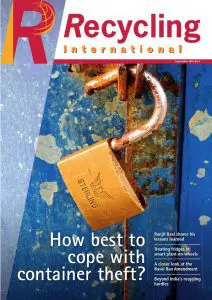Page 45 from: September 2014

45September 2014
P L A S T I C S
rials. KRS is a refuse plastic fuel (RPF) specialist,
converting plastic waste into compact nuggets
that are burned as fuel for energy. But according
to KRS president Lee Sang-Kuk, items such as
aluminium cans, chopsticks and spoons are
commonly found among the RPF waste stream.
KRS is one of the larger RPF operators in South
Korea. It was established by the Korean Plastic
Recycling Association and has acquired sorting
technology, which it uses to recycle around
7000 tonnes of household RPF waste each year.
But rather than concentrating RPF materials
among a handful of companies so that these
can be dealt with effectively, Lee points out that
there are another 150 RPF recycling companies
scattered around the country, nearly all work-
ing on a very small scale.
Solutions already exist
Examples such as these have given rise to
a widespread call for technology
solutions that can improve the
efficiency of South Korea’s
plastic recycling system;
however, the reality is
that these solutions
already exist. In 2005,
Korean company
Ionia E&T became
the first company in Asia to develop an auto-
matic sorting technology for the treatment of
municipal recyclable waste. This was on the back
of government funding as part of its 21st Cen-
tury Frontier Research & Development Project.
Ionia E&T’s Environment Business Depart-
ment manager Lee Ho-Ik claims that, with a
capacity of 3 tonnes per hour, this technology
is 10 times more efficient than sorting by hand
and has a sorting success rate of over 90%. Ionia
E&T’s automatic sorting system is now being
utilised by some 30 recycling centres around
the country.
International companies such as Norway’s TiTech
and France’s Pellenc ST are also spreading their
automated sorting technology across South
Korea, with the former’s machinery now used by
around 100 of the country’s recycling companies.
Despite the availability of this technology, how-
ever, it is yet to be utilised on a large scale.
Only a handful
So if South Korea’s Ionia E&T and interna-
tional companies like TiTech and Pellenc ST
have the technology to offer, then why is it not
being used more widely? According to Lee
Ho-Ik, the reason lies in the size of the South
Korean market; there are not enough large
companies that can afford it. All of the opera-
tions that currently use Ionia E&T’s machinery
are government-owned recycling centres, set
up in big cities and recycling large quantities.
Lee claims that there are only 50 or 60 large recy-
cling companies in the whole country, most of
which are government owned. In other words,
the majority of recycling companies are pri-
vately owned and small in size. The reality is that
with just one of Ionia E&T’s machines setting
you back US$ 240 000 (and a complete system
installation close to US$ 500 000), automated
recycling technology remains inaccessible to all
but a handful of the largest private companies.
And Lee doesn’t see the Korean market for its
technology solutions growing any bigger in the
near future. Facing up to the realisation that it
can sell machines perhaps to only two or three
local companies each year, Ionia E&T is now
looking for new markets overseas and plans to
start exporting in earnest next year.
Eliminating the what-ifs
In South Korea, a great deal of investment has
gone into recycling, the overall plastic recycling
rate is comparatively high and some great suc-
cess stories have been written. But speaking
more generally, the recycling system is not set
up with improvement in mind, and is thus not
as environmentally friendly and effective as it
could be. Assuming that the array of material
coming forward for recycling is not going to be
simplified any time soon, it would seem that
part of the answer lies in sorting technology.
But while this technology exists, the current
structure and, in particular, the small scale of
most sorting and recycling operations mean
change is not taking place. Given the current
international focus on South Korea and the
statements about the country’s technological
expertise and waste management successes, now
would seem to be a good time to implement
recycling solutions such that ‘what-if ’ scenarios
can be exchanged for a firm reality.
Thomas Vink is a representative of Latitude Lim-
ited, an enterprise that works with innovative
companies that offer sustainable solutions or
products for businesses and consumers in the
Korean market. Latitude is particularly focused
on delivering sustainable food packaging solu-
tions which refl ects it extensive experience and
networks in this area. The company also works
with partners to fi nd solutions for business and
home environments.
Thomas Vink can be contacted via:
[email protected]
www.atlatitude.com
‘The mountain of
waste on Nanji
Island was 34 times
larger than the Great
Pyramid of Giza.’
With a population of over 50 million people, South Korea consumes
around 5 million tonnes of plastics per year.
RI-7 Plastics South Korea.indd 45 28-08-14 14:38



